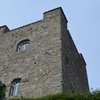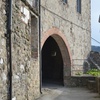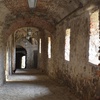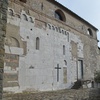Castle of Ghivizzano
Castle of Ghivizzano is situated on the top of an isolated hill, on the south-western slope of Mount Gromignana. Today, a considerable large part of the defensive structures of the fort remains and it is possible to recognize the route of the ancient walls surrounding the village, even if they are in ruins.
The Church of St. Peter and Paul originally played the role of the castle church, despite being located outside the fort. The structure has a single nave and over the altar are depictions of "The Faith", the "Fall of Saul" and the "Healing of the Cripple”, while in two niches on the sides are the statues of Saints Peter and Paul. Several 17th-century paintings are on display, including one of Saints Peter, Paul and Lawrence by Tiberio Franchi. The Romanesque layout is evident in the southern wall that ends in a series of hanging arches supported by human protomes. In the 18th century, when the church became a parish, it was considerably enlarged and altered. In 1885, a new substantial restoration was carried out and resulted in the placement of two tombstones: the first of Giovanna and Francesco Castracani, the other of their son Filippo.
In the Church of St. Anthony, of note are the ambo of a pulpit and a 15th-century baptismal font.
Historical notes
Ghivizzano Castle, already mentioned in 994, belonged to the noble family of the Rolandinghi. Conquered in 1171 by the city of Lucca, it passed to the Antelminelli family around the 14th century. Coming into the hands of Castruccio Castracani, the fortress expanded its walls to the church of St. Peter, already present in the Romanesque period, and most likely the walls of the village were built or rebuilt below.
When Castruccio died, the fort came under the domain of the City of Lucca. Shortly thereafter, along with the territory of Coreglia, it was occupied by Florentine troops, although Francesco Castracani managed to regain possession in 1352. In 1355, Charles IV confirmed rights to the county to the same Francesco Castracani, including possession of Borgo di Mozzano, Coreglia, this important castle settlement and many other settlements places beside. After a few years, in 1369, the fort came again under control of Lucca.
Under the rule of Paolo Guinigi, Ghivizzano was one of the castles identified as essential for the defence of the State. It was thus equipped with the necessary provisioning and four sergeants. A few years later, in 1437, the Florentine army seized it again and gave the County of Coreglia to Francesco Sforza, who transformed it into a small potentate. The lord, in 1441, decided to sell the territory to the Republic of Lucca when, on 14th May 1441, the men of Ghivizzano, together with the rest of the Vicariate of Coreglia, swore allegiance to the Elders of Lucca. From then on the castle followed the same fate as the administrative district to which it was subject.
The partial demilitarization of the area, in the second half of the 16th century, led to the transformation of the tower, in which were opened large windows to adapt the building for civil use.












